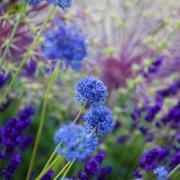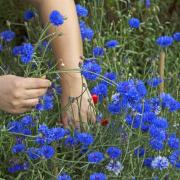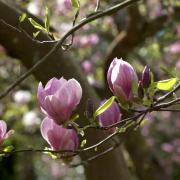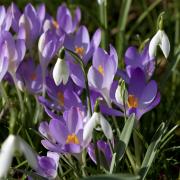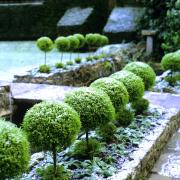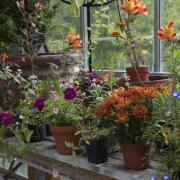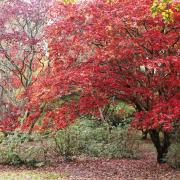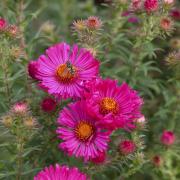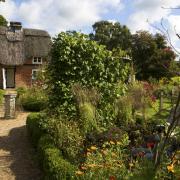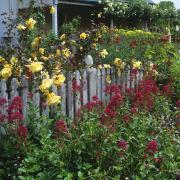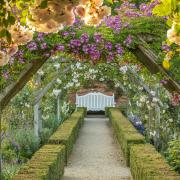As the National Trust celebrates 125 years of protecting the UK’s heritage, enjoy the autumn colours at two of Hampshire’s notorious properties
Autumn is crisp, colourful, and a treat for the senses. The golden and russet cloaks, the crunch of leaves underfoot and the elegant fading as plants begin their hibernation make this a special and contemplative season.
Many celebrations and events have had to be cancelled this year due to coronavirus; but one of the important milestones reached in 2020 was the 125th anniversary of the National Trust. As you stroll the autumnal splendour in Hampshire’s precious landscapes and gardens, take some time to reflect on the beauty and resilience of nature, as well as the contribution the Trust has made to open up this heritage to us all.
With the help of its supporters, this conservation charity, Europe’s largest, protects and cares for nature, beauty and history for the nation to enjoy. Independent of Government, it’s all thanks to the 5.6 million members, 65,000 volunteers and 14,000 staff that support it. Without this help, the organisation wouldn’t be able to care for the land, buildings, gardens and precious collections that it protects.
In Hampshire two of my favourite gems for an autumnal stroll are Mottisfont near Romsey, with gardens and landscape stretching out from an historical priory and Hinton Ampner near Bramdean, with its formal and woodland areas. Both are invigorating and will inspire ideas to translate to your own garden.
I chatted to Mottisfont’s head gardener Jonny Norton about the gardens and what to look out for in autumn.
“Mottisfont is famous for its walled rose garden housing the National Collection of pre-1900 roses, which mingle beautifully with companion perennials, shrubs and trees; it is considered by many to be the garden’s jewel in the crown. However, there are many other wonderful surprises to be found. In autumn, the stars of the show are the magnificent plane trees – another National Collection in fact.
“The Mottisfont Great Plane is the tallest in Europe and its huge buttery-yellow leaves reach right down to the ground. You can take in the towering veteran trees with their rich tapestry of autumn colour. You could even join in with the great Mottisfont Leaf Harvest - the garden team aim to make 150 tonnes of compost, so every leaf counts!
“Our beautiful kitchen garden is also worth visiting; the beds are less full than usual because lockdown prevented us from planting our autumn harvest crops, but you’ll find plenty of things to enjoy,” he comments.
Mottisfont is a garden that ‘sits’ on water, with a natural spring feeding little streams that twist and turn through the gardens, with a tributary of the famous River Test chalk stream running right through its centre. This atmospheric, constantly moving feature brings a sense of energy as you stroll along the streams, guaranteed to refresh your spirit.
Hinton Ampner’s garden was created by its last private owner, Ralph Stawell Dutton, the 8th and last Lord Sherbourne, designed to complement the elegant Georgian proportions of the imposing country manor, and much of the grounds are still as he created it during the 1930s.
The twelve-acre garden is on the bones of a Victorian garden, with a strong formal layout infilled with colour through the seasons and set with magnificent views across the South Downs.
“The garden is a masterpiece of design; Ralph Dutton was an art connoisseur and had a wonderful eye for detail. He set about terracing the garden, creating intimate garden rooms, vistas and pathways, and planted it with an impressive collection of shrubs and trees. The garden has a feeling of tranquillity and timelessness, and there are many spots where you can stop and take in a beautiful view,” explains John Wood, Hinton Ampner’s head gardener.
READ MORE: Exploring the Japanese themed Little Croft garden in Fleet
There are highlight plants to look out for in each season at Hinton Ampner, from iris, crocus and snowdrops in early spring, through to roses in summer, followed by masses of dahlias, with salvias continuing the show, to coloured foliage, rosehips and berries in autumn and then in December, winter-flowering jasmine and viburnum.
In autumn there are also hues of golds, bronze and red in the woodlands with wonderful walks to enjoy them. While in the walled vegetable garden, pumpkins, leeks, parsnips and onions draw the eye.
“Autumn is a strong season in terms of colour. We’ve got around 30 different varieties of dahlia, as well as salvias and nicotiana. Hinton Ampner has a large collection of shrubs and it’s always fascinating to see how they perform throughout the seasons. Viburnum plicatum ‘Pink Beauty’ is a great shrub to consider for a modest garden.
“Its wonderful white lace-cap flowers in spring mature to pink through summer, before turning into bright red fruit with rich red leaves in the autumn. Hydrangea quercifolia is another good option to consider, with large panicles of flowers that change colour with age, as do its large, oak-like leaves which turn from green to red, then eventually fall in winter to reveal the plant’s cinnamon bark,” suggests John.
A green ethos guides the National Trust’s on-going decisions, with the charity being a key player in the campaign to tackle climate change – the single biggest threat to the precious landscapes and historic houses it cares for.
From changing the way the Trust manages its gardens and cutting carbon emissions, to restoring wildlife habitats, it’s adapting in many ways.
“Over the last four years the gardens at Mottisfont have moved to a sustainable and organic way of gardening. We now make all our own compost using our garden waste, and collecting leaves from the many, many trees on the estate – something our younger visitors love helping with in the autumn!” adds Jonny.
To help mark its 125th anniversary, the Trust has committed to becoming carbon net zero by 2030, planting and establishing 20 million trees to help tackle climate change, creating green corridors for people and nature near towns and cities, running a year-long campaign to connect people with nature and continuing investment in arts and heritage.
“As we develop Hinton Ampner in terms of self-sufficiency, we always look at water catchment. The biomass boiler that heats the property has a large catchment tank and this is used to water the garden if needed. We try to propagate and grow as much on site as possible, which reduces the chances of importing pests and diseases,” comments John.
This unprecedented challenging year has been an incredibly tough one and the National Trust, like most charities, has been hit hard, with an expected loss this year of around £200 million. You can help by safely visiting properties and also by becoming a member to enjoy the vast range of properties and landscape for free.
Get the look
Plant your own leafy glade with small trees and shrubs that have autumnal foliage and multi-seasonal interest
The best time to plant trees, shrubs and bare-rooted herbaceous plants is between November and March. Planting before Christmas allows better establishment as the soil is warmer
Check the mature size is suitable for your space
Consider mature shape – some are broad, some narrow
Colour co-ordinate against your evergreens
Check aspect and soil needs
Top varities for autumn colour are: sorbus, crab apple, hawthorn, acer, nyssa, euonymus, cornus, fothergilla, hamamelis
Pay a visit
Mottisfont, Mottisfont, Romsey, SO51 0LP
Hinton Ampner, Bramdean, SO24 0LA
Advance booking is required to visit any house or garden, to limit visitor numbers and maintain public safety, and the safety of staff. Throughout this time, the organisation is urging people to ‘stay local’ – enjoying visits to their local garden and green space rather than travelling further afield
Don’t forget to follow us on Facebook, Instagram, and Twitter




